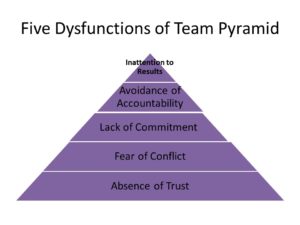By Rose O. Sherman, EdD, RN, NEA-BC, FAAN
 What happens when it is the senior leadership team that is dysfunctional? I have often wondered about the impact that this could have in an organization. My question was answered when I recently worked with a nonprofit agency with significant conflict among their senior leadership. As a team, they knew that they did not play well together. What was surprising to them was how aware their staff members were of the dysfunction on the senior leadership team. Staff provided some very insightful feedback on an all employee survey that indicated there was an atmosphere of distrust and conflict that started at the senior leadership level.
What happens when it is the senior leadership team that is dysfunctional? I have often wondered about the impact that this could have in an organization. My question was answered when I recently worked with a nonprofit agency with significant conflict among their senior leadership. As a team, they knew that they did not play well together. What was surprising to them was how aware their staff members were of the dysfunction on the senior leadership team. Staff provided some very insightful feedback on an all employee survey that indicated there was an atmosphere of distrust and conflict that started at the senior leadership level.
One of the best conceptual frameworks to understand team dysfunction was designed by Patrick Lencioni, author of The Five Dysfunctions of a Team. The figure below is a visual of the 5 dysfunctions:
The team I was coaching exhibited all five dysfunctions but the fundamental problems were an absence of trust and a fear of conflict. Lencioni describes these five dysfunctions as follows:
Absence of Trust – occurs because of an inability to show vulnerability about what you know and what you don’t. When there is trust on teams, the amount of political gamesmanship is reduced. Lencioni contends that a lack of trust often happens because team members know little about one another’s personal stories. This was certainly true on the team that I was coaching. Without knowledge of one another, it is easy to assume the worse about the behavior of another. To build trust on team, it can be very helpful to have all team members do assessments such as the Myers-Briggs, DISC or Gallup Strengths and share the findings with one another.
Fear of Conflict – effective teams must learn to manage the inevitable conflict that will occur. When teams manage conflict effectively, they can move past differences and avoid making the conflict destructive. In the team I coached, there was a high level of unexpressed conflict that had moved into the zone of mean-spirited personal attacks. Lecioni writes that to effectively manage conflict, teams must be OK with constructive debate and establish some clear rules of engagement. Understanding each team member’s style of conflict management can be extremely helpful in reducing fear of spirited discussion.
Lack of Commitment – high performing teams recognize that individual opinions will not always win out and that once a decision is made, everyone needs to commit to implementation. Lecioni contends that sometimes it is impossible to reach consensus and consensus decisions often lead to mediocrity. Instead, it should OK if there is healthy debate and not everyone agrees but there must be commitment to a final decision.
Avoidance of Accountability – effective teams have accountability to one another and not just to the leader. This was a major issue on the senior leadership team that I coached where the blame game and gossip had become part of the culture.
Inattention to Results – effective teams are results focused and worry about the impact of functions on collective goals and not just their areas/departments.
Once a team has become dysfunctional, it takes a very high level of commitment to get things back on track. Lecioni believes it can be done and offers some very specific steps in his field guide that accompanies the book. I have high hopes for the team that I was coaching. The staff feedback was so clear about what was happening that none of the senior leaders could deny that the team was dysfunctional. They also understood that when teams become dysfunctional, it is generally not an outcome of the behavior of just one individual. Everyone has contributed to the dysfunction and everyone needs to work to fix it.
Read to Lead
Lencioni, P. (2002). The Five Dysfunctions of a Team. San Francisco: Jossey-Bass.
Lencioni, P. (2005). Overcoming the Five Dysfunctions of a Team: A Field Guide. San Francisco: Jossey-Bass
© emergingrnleader.com 2018



 LinkedIn
LinkedIn Instagram
Instagram